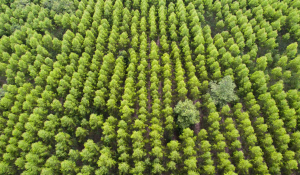Table of contents
1. What are the two kinds of climate contribution projects?
2. What are the 8 categories of climate contribution projects?
3. What criteria guarantee the quality of a climate contribution project?
4. Why is transparent communication on your environmental strategy essential to avoid greenwashing?
It is not always easy for a company to know which climate contribution project to choose, what criteria to consider, and how to ensure it doesn't affect its reputation. This article aims to guide you in selecting high-quality climate contribution projects.
Before further details, let's get a quick reminder of carbon offsetting. Followed by the various types of climate contribution projects.
One carbon credit represents one metric ton (OR tonne) of carbon dioxide (CO₂) or its equivalent in other greenhouse gases that has been either removed from the atmosphere, or prevented from being emitted through some project or activity.
In other words, organizations can compensate for the CO2 emissions they haven't managed to avoid by contributing to a certified emission reduction project (climate contribution project). It is important to remember that the contribution process is complementary to the reduction process of a company and should never replace it. The contribution consists of purchasing carbon credits, where one carbon credit corresponds to 1 tonne of CO2e.
1. What are the two kinds of climate contribution projects ?
Avoidance projects:
Projects that prevent carbon emissions that would have been released into the atmosphere. Projects examples include forest conservation, renewable energy, fuel switch, and household devices.
Removal projects:
Projects that reduce emissions by absorbing them from the atmosphere. Projects examples include afforestation, reforestation, improved forest management, and regenerative agriculture).
Discover the difference between carbon avoidance and carbon removal projects.
2. What are the 8 categories of climate contribution projects?
-
Forestry and Land Use: projects encompass a range of initiatives focused on sustainable management and utilization of forests and land resources.
- Renewable Energy: energy that is natural and self-replenishing. These are energies that are alternatives to fossil fuel electricity and heat production.
- Household and Community Devices: centers around benefiting local communities, using their knowledge and having them involved in the decision making processes.
- Blue Carbon: refer to Wetlands Restoration and Conservation (WRC) projects dedicated to protecting, rehabilitating, and conserving wetland ecosystems, including marshes, swamps, peatlands, and other ocean and coastal ecosystems.
- Waste Management: projects focus on how we handle waste to minimize its impact on the environment and on human health. Instead of treating waste as the last part of the production chain, these projects are working with the waste to create sources of energy, reduce pollution and reduce carbon emissions. These projects adopt a more circular approach to climate solutions.
- Agricultural Land Management: involves removing carbon from the atmosphere and sequestering it in the soil. Plants and crops make up part of the carbon cycle as they use CO2 from the air during photosynthesis. When the plants and crops decompose, some of the CO2 is stored in the ground and some is released back into the atmosphere.
- Transportation: one of the largest contributors to greenhouse gas emissions. These emissions primarily come from burning fossil fuel for our vehicles, ships, trains and planes.
3. What criteria guarantee the quality of a climate contribution project?
1. Project Certification
A project must be certified by an international or national standard to issue carbon credits. The standard differs depending on the project typology.
Here's the list of the most common international & national standards:
- Gold Standard
- Verra's Verified Carbon Standard (VCS)
- Plan Vivo
- Climate Action Reserve
- American Credit Registry
Third-party auditors verify the number of emissions absorbed or avoided during a specific period by the project compared to a baseline (base scenario), following methodologies established by the standards. Then the standards can issue the carbon credits. All credits generated by a certified project are accounted for on the standard's registry (each standard has its registry).
Registries are of fundamental importance to avoid the risk of double-counting, which occurs when two or more organizations monetize and claim the same credit. Once an organization decides to purchase carbon credits, intermediaries such as ClimateSeed settle the contribution on behalf of their clients, transferring the credits and canceling them once the credits are retired.
Following the Certification and the credit issuance, periodical monitoring and reporting activities are performed to ensure the continuity of the projects.
2. Real
All emission reductions and removals - and the project activities that generate them - shall be proven to have genuinely taken place.
3. Measurable
All emission reductions and removals shall be quantifiable, using recognized measurement tools (including adjustments for uncertainty and leakage) against a credible emissions baseline.
4. Additionality
The project needs to be issuing carbon credits in a threatened area so that the added value is real. Financial additionality, which means that the project could not exist without the issuance of carbon credits, is also needed.
5. Independently verified
All emission reductions and removals shall be verified to a reasonable level of assurance by an independent and qualified third party.
6. Unique
No more than one carbon credit can be associated with a single emission reduction or removal as one (1) metric ton of carbon dioxide equivalent (CO2e). Carbon credits shall be stored and retired in an independent public registry.
7. Permanence
Carbon credits shall represent permanent emission reductions and removals. Emission reductions represented by the carbon credits cannot be reversed after the issuance of the credits. Carbon credits shall represent permanent emission reductions and removals. Emissino reductions represented by the carbon credits cannot be reversed after issuance of the credis. This means, that in order for the credits to be valid, no fire or logging can/should happen at any point; an event that destroys the trees means that permanence is not meant as the sequestered carbon is released back into the atmosphere.
Where projects carry a risk of reversibility, at minimum, adequate safeguards shall be in place to ensure that the risk is minimized and that, should any reversal occur, a mechanism is in place that guarantees the reduction or removals shall be replaced or compensated. The internationally accepted norm for permanence is 100 years.
8. Co-benefits
Carbon reduction projects preserve the planet, help local communities, and protect biodiversity. They also support the achievement of the UN Sustainable Development Goals, which lead to co-benefits.

Co-benefits refer to all positive externalities enabled by the project and can consequently increase the quality of the project. The project should match your organization's environmental and social goals.
9. Transparency
Ensure that the price margins are clear and the money goes to local communities. It is important to purchase the credits from a transparent player as a common practice in the market is to buy the carbon credits through resellers, which most do not show transparent margins. As a result, contributors do not know how much of their contribution is going to the project and local communities.
No secondary market: the climate contribution to projects is a way to finance much-needed climate mitigation action and support the global transition to a zero-carbon future. Organizations (contributors) must avoid reselling the carbon credits and retire them from the market to complete the climate contribution action.
4. Why is transparent communication on your environmental strategy essential to avoid greenwashing?
Here are some tips:
- Communication must focus on the company's whole decarbonization strategy and consider removal or avoidance as a complementary action to strong reduction efforts. In other words, a company should report its annual carbon footprint (scope 1 & 2 and eventually scope 3) and detail its carbon reduction efforts before talking about carbon offsetting.
- It's more strategic to talk about climate contribution rather than carbon offsetting.
- Use the term carbon neutrality correctly. According to the IPCC definition, "carbon neutrality" is a generic term, scientifically valid when considered on a global level. It corresponds to a worldwide equilibrium between anthropogenic emissions and anthropogenic absorption. An organization, product, or service cannot be carbon neutral by itself but can contribute to achieving global carbon neutrality.
- Be careful when communicating about SDGs. Ensure you provide detailed information (KPIs) about how you target them.
Extreme weather events such as droughts and floods have a greater impact on the poor and most vulnerable. Supporting emission reduction projects can allow companies and individuals to truly positively impact the environment and society.
Measure, Reduce, Contribute, and Report. These are the four steps for an effective strategy to reach net-zero emissions, which have become necessary to reach the 1.5°C goal established by the Paris Agreement.
For more information on Carbon Removal Methods, download our guide.
Q&A
Companies have long used carbon offsetting to demonstrate their commitment to sustainability without actually reducing their greenhouse gas emissions, which has been criticized as greenwashing by environmental NGOs. Offsetting is seen as a way to pay to pollute without making reduction efforts. Due to this negative reputation and ambiguous terminology, it is now essential to talk about "climate contribution" rather than "carbon offsetting" to encourage direct and responsible actions in the fight against climate change. For more information on this topic, please refer to our article.
A carbon avoidance project aims to prevent greenhouse gas emissions that would otherwise have occurred, for example, by using renewable energy instead of fossil fuels. In contrast, a carbon removal project involves capturing and storing carbon already present in the atmosphere, through means such as reforestation, which absorbs CO₂ through the growth of trees. In summary, avoidance reduces future emissions, while sequestration removes existing carbon. Read our article on this topic for more information.
References :
- (1)Selin N.E., "Carbon Offset," 2011, Encyclopaedia Britannica, available at: https://www.britannica.com/technology/carbon-offset/additional-info
- IPCC: https://www.ipcc.ch/reports
Share this
You May Also Like
These Related Stories

Why Avoidance Credits are not Inherently Inferior to Removal Ones

The difference between carbon removal & carbon avoidance projects


